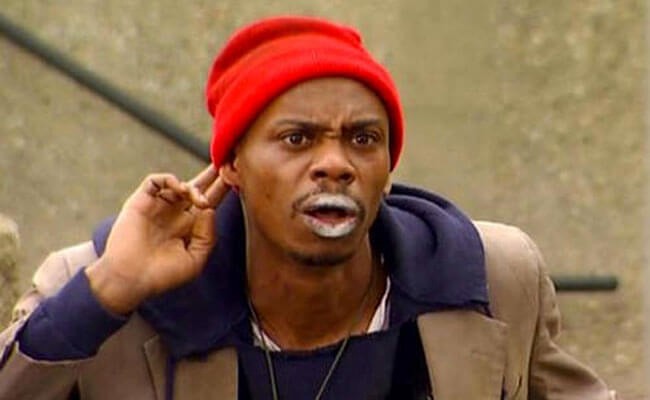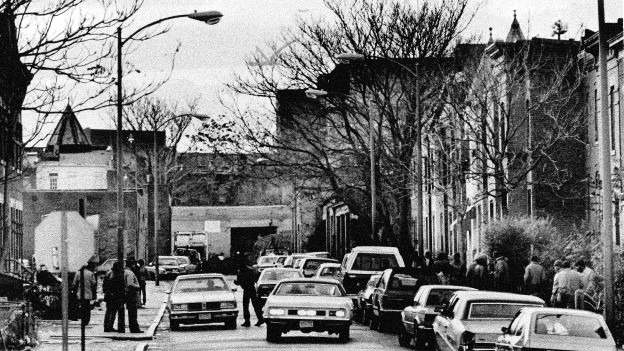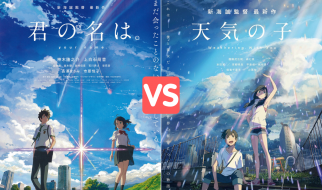 Dave Chappelle portraying crackhead Tyrone Biggums, one of the characters from his sketches
Dave Chappelle portraying crackhead Tyrone Biggums, one of the characters from his sketches
David Chappelle knows a thing or two about being high on crack. While not actually doing the drug himself, Chapelle?s experience watching his home city become a major crack distribution epicenter is the influence behind his crackhead characters and stand-up jokes. Instead of getting a high from crack itself, Dave?s high comes generating laughs from an audience. Dave Chappelle can crack jokes about crack, which are humorous at the surface, but closer examination highlights a more serious issue. Growing up around the D.C. area, Chappelle has witnessed the devastation crack causes in a community. He watched the nations capital become a warzone, fueled by drugs and gang violence. By the late 1990s D.C. was plagued with drug addiction, crime, and homelessness, deriving from the cities central role in the crack trade. Chappelle uses comedy as an outlet to express his perspective on the crack epidemic. This essay will look at one particular joke from his 2000 standup comedy Dave Chappelle: Killin? Them Softly, and dissect the deeper meaning behind the joke, as it relates to the crack epidemic in D.C.
The 80s and 90 brought us fanny packs, leg warmers, and the Macarena. These are all things society can look back at and laugh at, but instead Dave Chappelle chooses to make a joke that roots from something much more sinister: crack. The joke goes as follows:
I seen one crackhead trying to break into somebody?s car, man? and it struck a chord with me. I tried to stop it. I said,? Hey!? And he looked back and saw me and said:? Keep an eye out.? I said,? Nigger, that was me that said that. I?m not trying to help you.? I want this shit to stop.? Crackheads are like that. I had a crackhead break my car window one time. Broke it. You know what he stole? Fucking candy bar I had lying on the seat. That?s all he took. Just a goddamn candy bar.
The first line of the joke has a serious tone. Dave sees a crackhead committing a crime, which is not okay with him. On the surface, it may seem like Dave is just setting up the premise of the joke, but peel back a few layers and more is revealed. Dave is shedding light on the issue of crack and crime, which seem to go hand-in-hand. He states that ?it struck chord with me? because Dave has grown up in an era where crack use and drug related crimes were running rampant through Washington D.C.. During the 80s, crack hit the streets of the District of Columbia and chaos ensued, specifically in black neighborhoods. Crack use skyrocketed, which had a strong negative impact on the community. Sixty percent of inmates incarcerated in the U.S. were sentenced on drug-related charges. Additionally, fetal death rates, low birth weight and number of children in foster care increased significantly in black communities. This is an adverse effect of crack destroying families. Instead of caring for their children, crack addicts were using all their resources to buy drugs and once they ran out of money, they were forced to start committing crimes to support their addiction. Dave?s history of seeing people like this in his home city is the inspiration behind his crackhead jokes, and he uses his comedic abilities to provide social commentary on his experience in this era. What seems like a humor introduction to a joke, is in actuality, a reflection of the harsh reality Chappelle witnessed in the D.C. community.
 Cars lined up and down the street waiting for dealers to serve them crack
Cars lined up and down the street waiting for dealers to serve them crack
In the next section of the joke, Chappelle is trying to plead with the crackhead to stop, but the delusional drug addict is clearly out of his mind and asks Chappelle to be his lookout. This relates to how drug dealers would recruit younger kids to start helping them deal their drugs. On blocks with heavy drug traffic, children would be asked to keep watch for police and warn the dealers if any cops were coming through their block. This is how the drug trade would spread in the community. Innocent children would start by being lookouts and, over time, were given more responsibility, until they were the ones dealing drugs and committing crimes. Kids were given what seemed like a great opportunity, to climb up the economic ladder, gain respect from the dealers they looked up too and get out of poverty. However, an increasing number of dealers created conflict over clients and territory, which resulted in mass violence and casualties. Between 1984 and 1989 the homicide rate for black males ages 14 to 17 and ages 18 to 24 more than doubled. Washington D.C. became known as the ?Murder Capital of the United States?. Crack was like a contagious disease and once it found it?s way into a community, it spread like wildfire. After further investigation into this section of the joke, it seems like Chappelle may have been commenting on how easy it was for people in the black community to be sucked into the dangerous life of murder, crack dealing and crack use. Chappelle states in the joke ?I want this shit to stop?. This is how millions of onlookers felt as they witnessed the destruction of black, inner city communities in Washington D.C. during the horrific period.
This type of joke reflects Dave Chappelle?s overall body of work. His humor is often centered race and he uses humor to give social commentary on the back experience. Throughout the rest of Killin? Them Softy, Chappelle delivers jokes on racism, dealing with police and other aspects of the experiences of a black. However, the most common trend in his humor, whether it be in stand up, or sketch comedy, is the persistent incorporation of crack. One of Chappelle?s most well know comedy sketch characters is Tyrone Biggums, a homeless crack addict.
I believe him growing up around Washington D.C. during the crack epidemic was the inspiration behind these jokes and characters. Chappelle growing up while experiencing the crack epidemic influenced life around him. Issues surrounding crack in D.C. filled his evening news, and drug dealing themed raps from the likes of Biggie Smalls and Jay-Z filled his ears. All these contributing factors had a lasting impact on Chappelle?s humor and are the inspiration behind his crack-inspired comedy.


